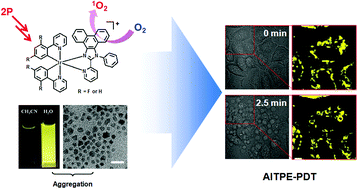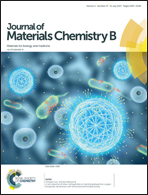Two-photon photodynamic ablation of tumor cells by mitochondria-targeted iridium(iii) complexes in aggregate states†
Abstract
By integrating targeting, imaging and treatment, organelle-targeted photodynamic therapy (PDT) has been reported to be an effective strategy for cancer therapy. However, targeting leads to the accumulation of photosensitizers (PSs) in the targeted organelles, which leads to a reduction in 1O2 generation and fluorescence quenching, especially for the lipophilic mitochondria-targeted PSs. Moreover, because PSs always need exposure to light for a specific period, photobleaching is difficult to avoid. To address these issues, two iridium(III) complexes with aggregation-induced two-photon emission (AITPE) characteristics were developed. With lipophilicity, the complexes aggregated in water and targeted mitochondria. Owing to their impressive 1O2 production quantum yields and excellent two-photon properties in the aggregate states, the complexes were successfully used for mitochondria-targeted two-photon PDT in monolayer cells and multicellular spheroids. Our results highlighted that the use of a PS with aggregation enhanced 1O2 generation and fluorescence is an effective solution for aggregation in organelle-targeted PDT.



 Please wait while we load your content...
Please wait while we load your content...